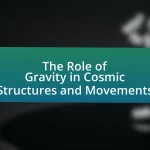Dark matter is a crucial component in the formation and evolution of galaxies, constituting approximately 27% of the universe’s total mass-energy content. Its gravitational influence shapes the structure of galaxies, affects the distribution of visible matter, and plays a significant role in the dynamics of galactic interactions. Observational evidence, such as galaxy rotation curves and gravitational lensing, supports the existence of dark matter and its essential role in galaxy formation. Various models, including Cold Dark Matter and Modified Newtonian Dynamics, explore dark matter’s impact on cosmic evolution and the long-term fate of galaxies, while ongoing research continues to enhance our understanding of its effects through advanced simulations and observational studies.

What is the Influence of Dark Matter on Galactic Formation?
Dark matter significantly influences galactic formation by providing the necessary gravitational framework for galaxies to form and evolve. Its presence affects the distribution of visible matter, leading to the formation of structures such as galaxies and galaxy clusters. Observations indicate that dark matter constitutes approximately 27% of the universe’s total mass-energy content, which is crucial for the gravitational binding of galaxies. For instance, simulations of cosmic structure formation, such as those conducted by the Millennium Simulation project, demonstrate that dark matter halos are essential for the clustering of baryonic matter, ultimately resulting in the formation of galaxies.
How does dark matter contribute to the structure of galaxies?
Dark matter significantly contributes to the structure of galaxies by providing the gravitational framework necessary for their formation and stability. This unseen mass, which constitutes approximately 27% of the universe, influences the rotation curves of galaxies, leading to the observation that stars at the outer edges of galaxies rotate at higher speeds than expected based on visible matter alone. This discrepancy indicates the presence of dark matter, which extends well beyond the visible components of galaxies, forming a halo that helps bind galaxies together and affects their overall shape and dynamics. Observations from the Cosmic Microwave Background and galaxy cluster dynamics further support the existence of dark matter, confirming its critical role in shaping the large-scale structure of the universe and the formation of galaxies.
What role does dark matter play in the gravitational dynamics of galaxies?
Dark matter plays a crucial role in the gravitational dynamics of galaxies by providing the majority of the mass that influences their structure and behavior. Observations indicate that galaxies rotate at speeds that cannot be explained solely by the visible matter they contain; this discrepancy suggests the presence of dark matter, which does not emit light but exerts gravitational forces. For instance, the rotation curves of spiral galaxies show that stars at the outer edges rotate at similar speeds to those closer to the center, a phenomenon that can only be accounted for by the existence of a dark matter halo surrounding the galaxy. This halo contributes significantly to the overall gravitational pull, affecting the formation and stability of galaxies over cosmic time.
How does dark matter affect the distribution of visible matter in galaxies?
Dark matter significantly influences the distribution of visible matter in galaxies by providing the gravitational framework necessary for galaxy formation and structure. The presence of dark matter, which constitutes approximately 27% of the universe’s mass-energy content, creates a gravitational potential well that attracts baryonic matter, leading to the formation of stars and galaxies. Observations, such as those from the Bullet Cluster, demonstrate that visible matter (like gas and stars) is concentrated in regions where dark matter is more abundant, indicating that the gravitational effects of dark matter dictate the arrangement and density of visible matter. Additionally, simulations of galaxy formation, like those conducted by the Millennium Simulation, show that dark matter halos are essential for explaining the observed rotation curves of galaxies, which reveal that stars in the outer regions of galaxies rotate at higher speeds than would be expected based solely on visible matter. This discrepancy is attributed to the unseen mass of dark matter, confirming its critical role in shaping the distribution of visible matter within galaxies.
Why is dark matter essential for understanding galaxy formation?
Dark matter is essential for understanding galaxy formation because it provides the gravitational framework necessary for galaxies to form and evolve. Observations indicate that visible matter alone cannot account for the gravitational forces required to hold galaxies together; dark matter constitutes approximately 27% of the universe’s total mass-energy content, influencing the structure and dynamics of galaxies. For instance, simulations of cosmic structure formation show that dark matter halos serve as the scaffolding around which visible matter accumulates, leading to the formation of galaxies. This is supported by the cosmic microwave background radiation data from the Planck satellite, which reveals the density fluctuations in the early universe that facilitated the growth of dark matter structures, ultimately shaping the galaxies we observe today.
What evidence supports the existence of dark matter in galactic formation?
The existence of dark matter in galactic formation is supported by several key pieces of evidence, primarily the observed rotation curves of galaxies. These curves indicate that stars in the outer regions of galaxies rotate at much higher speeds than would be expected based on the visible mass alone. For instance, the rotation curve of the Milky Way shows that stars at the edge of the galaxy move at speeds that suggest the presence of additional unseen mass, which is attributed to dark matter.
Furthermore, gravitational lensing provides additional evidence; light from distant galaxies is bent around massive objects, and the amount of bending indicates more mass than what is visible. Studies, such as those conducted by the Hubble Space Telescope, have shown that the mass required to explain the lensing effects often exceeds the mass of the visible matter, reinforcing the dark matter hypothesis.
Additionally, simulations of cosmic structure formation, like those from the Millennium Simulation, demonstrate that the distribution of galaxies and galaxy clusters aligns with predictions made by models that include dark matter. These simulations show that without dark matter, the large-scale structure of the universe would not match observations.
Together, these pieces of evidence—galactic rotation curves, gravitational lensing, and cosmological simulations—strongly support the existence of dark matter as a crucial component in the formation and evolution of galaxies.
How do simulations of galaxy formation incorporate dark matter?
Simulations of galaxy formation incorporate dark matter by modeling its gravitational effects on baryonic matter and the overall structure of the universe. These simulations utilize dark matter as a crucial component, often represented through particle-based models, to simulate the formation of cosmic structures over time. For instance, the Cold Dark Matter (CDM) model is widely used, where dark matter particles interact only through gravity, allowing researchers to observe how galaxies form and evolve under its influence. Studies, such as those conducted by Springel et al. in the Millennium Simulation, demonstrate that dark matter’s gravitational pull is essential for the clustering of matter, leading to the formation of galaxies and large-scale structures.
What are the different theories regarding dark matter’s role in galaxies?
Dark matter is theorized to play a crucial role in the formation and structure of galaxies through several key theories. The most prominent theory is the Cold Dark Matter (CDM) model, which posits that dark matter consists of slow-moving particles that clump together under gravity, leading to the formation of galaxies and large-scale structures in the universe. This model is supported by observations of the cosmic microwave background radiation and the distribution of galaxies, which align with predictions made by simulations based on CDM.
Another theory is the Modified Newtonian Dynamics (MOND), which suggests that the effects attributed to dark matter can be explained by modifying the laws of gravity at low accelerations. MOND has been successful in explaining the rotation curves of galaxies without invoking dark matter, but it struggles to account for large-scale structures and cosmic evolution.
Additionally, the Self-Interacting Dark Matter (SIDM) theory proposes that dark matter particles can interact with each other, leading to different clustering behaviors compared to CDM. This theory aims to resolve discrepancies in galaxy formation and structure observed in simulations versus real-world data.
Lastly, the Emergent Gravity theory posits that gravity is not a fundamental force but emerges from the entropic behavior of microscopic degrees of freedom, potentially eliminating the need for dark matter altogether. However, this theory remains controversial and lacks widespread acceptance.
These theories collectively illustrate the ongoing efforts to understand dark matter’s role in galaxies, with varying degrees of support from observational evidence and theoretical frameworks.
How do various models explain the influence of dark matter on galaxy evolution?
Various models explain the influence of dark matter on galaxy evolution by highlighting its role in gravitational interactions and structure formation. The Lambda Cold Dark Matter (ΛCDM) model, for instance, posits that dark matter provides the necessary gravitational scaffolding for baryonic matter to coalesce into galaxies, leading to the observed large-scale structure of the universe. Simulations based on this model, such as the Millennium Simulation, demonstrate how dark matter halos form and evolve, influencing the distribution and dynamics of galaxies.
Additionally, the hierarchical model of galaxy formation suggests that galaxies form through the merging of smaller structures, with dark matter facilitating these mergers by providing the gravitational pull needed to overcome the kinetic energy of the baryonic matter. Observational evidence, such as the cosmic microwave background radiation measurements from the Planck satellite, supports the existence of dark matter and its critical role in shaping the universe’s evolution.
Furthermore, alternative models, like the Modified Newtonian Dynamics (MOND), attempt to explain galaxy rotation curves without invoking dark matter, but they struggle to account for the large-scale structure and cosmic evolution observed in the ΛCDM framework. Thus, the prevailing consensus remains that dark matter is essential for understanding galaxy evolution, as it influences both the formation of galaxies and their subsequent interactions.
What are the key differences between cold dark matter and warm dark matter models?
Cold dark matter (CDM) and warm dark matter (WDM) models differ primarily in their particle properties and the implications for structure formation in the universe. CDM consists of heavy, slow-moving particles that allow for the formation of small-scale structures, such as galaxies, early in the universe’s history, leading to a hierarchical structure formation scenario. In contrast, WDM consists of lighter, faster-moving particles that suppress the formation of small-scale structures, resulting in a smoother distribution of matter and a different evolution of cosmic structures.
The differences in particle mass and velocity lead to distinct predictions regarding the abundance of small galaxies; CDM predicts a higher number of small galaxies, while WDM predicts fewer due to its suppression effects. Observational evidence, such as the distribution of galaxies and the cosmic microwave background radiation, supports the CDM model, but WDM has been proposed to address certain discrepancies in galaxy formation and distribution.
How do alternative theories, such as Modified Newtonian Dynamics, challenge traditional views?
Alternative theories like Modified Newtonian Dynamics (MOND) challenge traditional views by proposing that the laws of gravity and motion differ at low accelerations, which contradicts Newtonian physics and general relativity. MOND suggests that the observed rotation curves of galaxies can be explained without invoking dark matter, asserting that the gravitational effects attributed to dark matter are instead a result of modifications to Newton’s laws. This theory gained traction after researchers observed that galaxies rotate at speeds that cannot be accounted for by the visible mass alone, leading to the conclusion that either dark matter exists or that our understanding of gravity needs revision. The implications of MOND challenge the prevailing cosmological models that rely heavily on dark matter, thus prompting a reevaluation of galactic formation theories.
What implications do these theories have for our understanding of the universe?
The theories regarding dark matter significantly enhance our understanding of the universe by explaining the formation and structure of galaxies. Dark matter, which constitutes approximately 27% of the universe, provides the necessary gravitational framework that influences how galaxies form and evolve. For instance, simulations and observations, such as those from the Hubble Space Telescope, demonstrate that dark matter halos are essential for holding galaxies together and facilitating their growth through mergers and interactions. This understanding reshapes our perception of cosmic evolution, indicating that visible matter alone cannot account for the observed large-scale structures in the universe.
How might dark matter influence the formation of large-scale structures in the universe?
Dark matter significantly influences the formation of large-scale structures in the universe by providing the necessary gravitational framework for galaxies and galaxy clusters to form. Its presence, which constitutes about 27% of the universe’s total mass-energy content, creates gravitational wells that attract ordinary matter, leading to the clumping of gas and dust into stars and galaxies. Observations of cosmic microwave background radiation and galaxy distribution reveal that dark matter’s gravitational effects are essential for explaining the observed large-scale structure, as simulations incorporating dark matter align closely with the actual distribution of galaxies in the universe.
What are the potential consequences of dark matter’s properties on cosmic evolution?
Dark matter’s properties significantly influence cosmic evolution by affecting the formation and structure of galaxies. The gravitational effects of dark matter lead to the clustering of visible matter, which is essential for galaxy formation. Observations indicate that dark matter constitutes approximately 27% of the universe’s mass-energy content, shaping the large-scale structure of the cosmos and influencing the distribution of galaxies. For instance, simulations of cosmic evolution, such as those conducted by the Millennium Simulation project, demonstrate that dark matter halos are critical for the gravitational binding of galaxies, thereby determining their formation and growth over time.

How does dark matter interact with other cosmic components during galactic formation?
Dark matter interacts with other cosmic components during galactic formation primarily through gravitational forces. This interaction facilitates the clumping of baryonic matter, such as gas and dust, which is essential for star formation. Observations indicate that dark matter halos provide the necessary gravitational wells that attract and retain baryonic matter, leading to the formation of galaxies. For instance, simulations of cosmic structure formation show that regions with higher dark matter density correlate with areas of increased star formation, supporting the idea that dark matter plays a crucial role in shaping the structure and evolution of galaxies.
What is the relationship between dark matter and baryonic matter in galaxies?
Dark matter and baryonic matter in galaxies are interconnected, with dark matter providing the gravitational framework that influences the formation and distribution of baryonic matter. Dark matter constitutes approximately 85% of the total mass in the universe, while baryonic matter, which includes stars, gas, and dust, makes up the remaining 15%. The presence of dark matter affects the rotation curves of galaxies, leading to the observation that galaxies rotate at speeds that cannot be explained solely by the visible baryonic matter. This discrepancy indicates that dark matter plays a crucial role in holding galaxies together and shaping their structure, as evidenced by studies such as the rotation curve analysis of spiral galaxies, which shows that the mass distribution inferred from rotation speeds requires a significant amount of unseen mass, attributed to dark matter.
How does dark matter affect star formation rates in galaxies?
Dark matter significantly influences star formation rates in galaxies by providing the necessary gravitational framework that facilitates the accumulation of baryonic matter. This gravitational pull helps to stabilize gas clouds, allowing them to collapse and form stars. Observational evidence, such as the rotation curves of galaxies, indicates that the presence of dark matter is essential for maintaining the structural integrity of galaxies, which in turn affects the efficiency of star formation. Studies have shown that galaxies with higher dark matter concentrations tend to have increased star formation activity, as the gravitational influence enhances the conditions for star formation by compressing gas and dust.
What role does dark matter play in the interaction between galaxies?
Dark matter plays a crucial role in the interaction between galaxies by providing the gravitational framework that governs their motion and formation. This unseen mass influences the dynamics of galaxies, affecting their rotation curves and the way they interact during collisions and mergers. Observations, such as those from the Bullet Cluster, demonstrate that the majority of mass in these interactions is attributed to dark matter, which does not emit light but can be detected through its gravitational effects. Additionally, simulations of galaxy formation, like those conducted by the Millennium Simulation, show that dark matter halos are essential for the clustering of galaxies, thereby shaping the large-scale structure of the universe.
How does dark matter influence the fate of galaxies over time?
Dark matter significantly influences the fate of galaxies over time by providing the gravitational framework necessary for their formation and evolution. This unseen mass, which constitutes approximately 27% of the universe, affects the motion of galaxies and their interactions. For instance, dark matter halos surround galaxies, dictating their structure and stability, and facilitating the merging of smaller galaxies into larger ones, a process essential for galaxy growth. Observational evidence, such as the rotation curves of spiral galaxies, shows that the outer regions rotate faster than expected based on visible matter alone, indicating the presence of dark matter. Additionally, simulations of cosmic structure formation demonstrate that dark matter plays a crucial role in the clustering of galaxies, influencing their distribution and the large-scale structure of the universe.
What are the long-term effects of dark matter on galaxy mergers and interactions?
The long-term effects of dark matter on galaxy mergers and interactions include the stabilization of galaxy structures and the enhancement of gravitational interactions. Dark matter, which constitutes approximately 27% of the universe’s mass-energy content, exerts gravitational forces that influence the dynamics of galaxies during mergers. This gravitational influence helps to retain gas and stars within merging galaxies, promoting star formation and the growth of supermassive black holes at their centers. Studies, such as those by Springel et al. (2005) in “Simulations of the Formation of Galaxy Clusters,” demonstrate that dark matter halos provide the necessary gravitational scaffolding for galaxies to merge and evolve over billions of years, ultimately leading to the formation of larger galactic structures.
How does dark matter contribute to the eventual fate of the universe?
Dark matter plays a crucial role in determining the eventual fate of the universe by influencing its expansion and structure formation. Its gravitational effects help to bind galaxies together and affect the rate at which the universe expands. Observations, such as those from the Cosmic Microwave Background radiation and galaxy cluster dynamics, indicate that dark matter constitutes about 27% of the universe’s total mass-energy content, significantly impacting cosmic evolution. The presence of dark matter leads to a scenario where the universe’s expansion could either continue indefinitely or eventually slow down and collapse, depending on the balance between dark energy and dark matter’s gravitational pull.
What are the current research trends in studying dark matter’s influence on galactic formation?
Current research trends in studying dark matter’s influence on galactic formation focus on the role of dark matter in shaping galaxy structures and dynamics. Researchers are utilizing advanced simulations and observational data to understand how dark matter halos affect the formation and evolution of galaxies. For instance, studies like the IllustrisTNG project have provided insights into the interplay between dark matter and baryonic matter, revealing how dark matter influences star formation rates and galaxy morphology. Additionally, gravitational lensing techniques are being employed to map dark matter distribution in galaxies, enhancing our understanding of its impact on galactic formation processes.
What new technologies are being developed to detect dark matter’s effects?
New technologies being developed to detect dark matter’s effects include advanced particle detectors, such as the Large Underground Xenon (LUX-ZEPLIN) experiment, which aims to identify weakly interacting massive particles (WIMPs) through sensitive detection of light and ionization signals in liquid xenon. Additionally, the use of cryogenic detectors, like the SuperCDMS experiment, is being explored to measure energy deposits from potential dark matter interactions at extremely low temperatures. These technologies are designed to enhance sensitivity and improve the ability to observe rare events associated with dark matter, thereby providing insights into its role in galactic formation.
How are observational studies enhancing our understanding of dark matter in galaxies?
Observational studies are enhancing our understanding of dark matter in galaxies by providing empirical data that reveals the distribution and effects of dark matter on galactic structures. For instance, gravitational lensing observations show how light from distant galaxies is bent by the mass of dark matter, allowing scientists to map its presence and density in galaxy clusters. Additionally, studies of galaxy rotation curves indicate that stars in the outer regions of galaxies rotate at higher speeds than expected based on visible matter alone, suggesting a significant amount of unseen mass, attributed to dark matter, is influencing these dynamics. These findings collectively support the existence of dark matter and its critical role in shaping galaxies, as evidenced by the correlation between dark matter density profiles and galaxy formation models.




